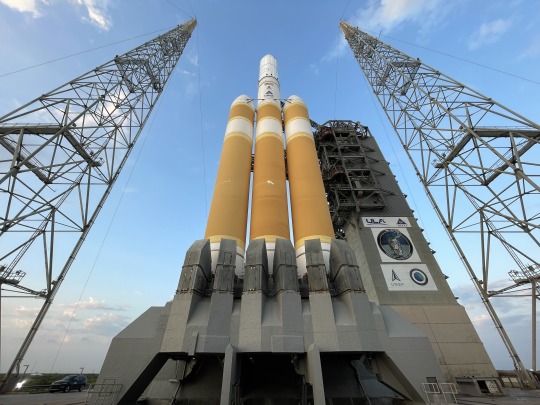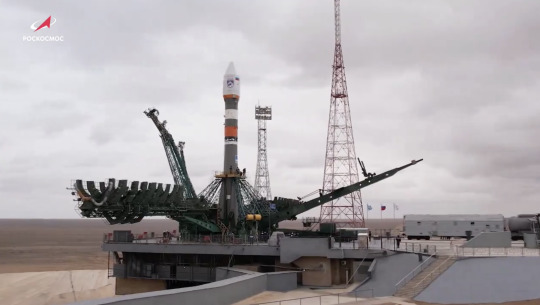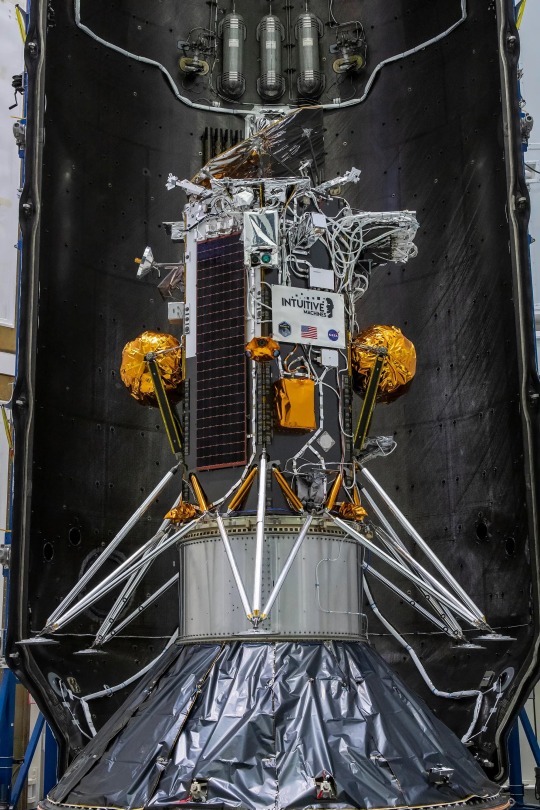Text
youtube
Russian EVA-62 will be conducted today (24 Apr) from 3:55pm BST to about 10pm BST. Coverage on NASA TV
0 notes
Text
youtube
live coverage of Shenzhou 18 launch on now, launch is scheduled for 14:59BST...
0 notes
Text

Update: Third launch attempt today (11 Apr) see link below...
Update: Venting occurred at T-2 minutes and 45 seconds (never a good sign as it means the tanks are depressurising from their flight ready pressure). Some announcement was made in Russian and then the feed from the launch site ended. Later is was reported that a failure of the URM-1 oxidizer tank pressurization system had occurred and the launch was cancelled automatically. Since the core stage and the booster are all URM-1s, a common design, I'm not sure what that means. No news on a reschedule so far
Also launching today (9 Apr) will be the fourth test launch of the Russian Angara A5 launcher, but it will be the first launch from the new Site 1A pad at Russia's newest cosmodrome, Vostochny in East Russia. The Angara A5 is intended to replace the Proton, but it's development has been protracted. It first launched on 14 December 2020, the third launch on 27 December 2021 ended in failure when the upper stage failed to relight, although the launcher itself performed well.
youtube
0 notes
Text

Today (9 Apr) the 16th and last flight of the D4H will take place and the last flight of any Delta 4 version. The last launch attempt on 28 March was aborted at T-3 mins 58 seconds after a pump on the ground gaseous nitrogen line failed. The gas is used to power pneumatic systems. Then a plan to launch the following day had to be abandoned when the back-up pump failed to work at all.
The first Delta 4 launched in 2002 and the first Delta 4 Heavy in 2004. ULA plans to replace both with the new Vulcan Centaur which conducted it's first test launch on 8 January (launching the ultimately ill fated Astrobotic Peregrine lunar lander).
The NRO/USSF payload is classified but is believed to be (thanks to Ed Snowden) Orion-12/Mentor-10, an enormous geostationary spy satellite with a 100m (328ft) dish antenna (when unfurled) originally designed to pick up military command communications but which can now pick up mobile phone and text messages. The things are so big they can appear as an 8th magnitude star, but which unlike a star stays in exactly the same place in the sky. Pic: ULA (from 28 March).

youtube
0 notes
Text





Russia will finally launch its next civilian Earth observation satellite, Resurs-P 4, after scrabbling around for bits for a few years. It looks very Russian, two large solar arrays will deploy on each side.
It will launch from Site 31/6 Baikonur at 10:36BST onboard a Soyuz 2-1b.
It is equipped with a Geotin-L1 multi-special imager with a 1m resolution, a NPP Opteks ShMSA-VR 200m high resolution camera, a NPP Opteks ShMSA-SR 40mm medium resolution camera an a GSA hyperspatial camera operating in 5-10nm wavelengths with a 30m resolution. Hyperspecral camras collect a vast portion of the EM spectrum instead of just light (and instead of just specic bands as in mulispectral images), optaining a spectrum for each pixel of the image. Built by NPP Opteks, Roscosmos and optics producer Krasnogorsky Zavod (KMZ known also for Zorki and Zenit cameras).
Launch scheduled for 10:36BST
0 notes
Text

Update: The launch of Delta IV Heavy carrying the NROL70 mission for the National Reconnaissance Office is now planned for Tuesday, April 9 at 12:53 p.m. EDT (17:53BST), pending range approval. The launch on Thursday (28 Apr) was aborted at T-3 mins 58 seconds after a pump on the ground gaseous nitrogen line failed. The gas is used to power pneumatic systems, not sure what, maybe launch clamps and such. After the pump failed again during post launch attempt testing the Mobile Service Tower was moved back around the rocket.
Today the 16th and last flight of the D4H will take place and the last flight of any Delta 4 version. The first Delta 4 launched in 2002 and the first Delta 4 Heavy in 2004. ULA plans to replace both with the new Vulcan Centaur which conducted it's first test launch on 8 January (launching the ultimately ill fated Astrobotic Peregrine lunar lander).
The NRO/USSF payload is classified but is believed to be (thanks to Ed Snowden) Orion-12/Mentor-10, an enormous geostationary spy satellite with a 100m (328ft) dish antenna (when unfurled) originally designed to pick up military command communications but which can now pick up mobile phone and text messages. The things are so big they can appear as an 8th magnitude star, but which unlike a star stays in exactly the same place in the sky. Pic: ULA
Launch is currently scheduled for 18:45GMT today (28 Mar). Coverage from ULA from 18:15GMT at...

0 notes
Text

After last Thursdays (21 Mar) automatic abort at T-20 seconds Soyuz MS-25/71S will be trying again today (23 Mar). Onboard is visiting crew of Soyuz Commander Lieutenant Colonel Oleg Novitsky of the Russian AF, a veteran of three Expeditions to the station. NASA astronaut Tracy Caldwell-Dyson (left) will be staying onboard the station replacing her colleague Loral O'Hara. Marina Vasilevskaya is the first female astronaut from Belarus, the is an air hostess, I think they held some kind of competition. Novitsky, Vasilevskaya and O'Hara will return in about 12 days. They will return on Soyuz MS-24-70S (leaving a fresh Soyuz for the long stay crew). The problem on Thursday that caused the abort was the detection of low voltage in the electrical systems of the Soyuz 2.1a rocket (they are both called Soyuz confusingly). This time they won't be able to do the two hour trajectory to the ISS and instead it will take until Monday. To do the quick approach you need the ISS to fly directly overhead at launch and that won't happen again for a while. Pic: NASA/Roscosmos
• Thursday 23 March 2024: Launch
GMT (EDT)
12:00 (08:00) LAUNCH COVERAGE
12:36 (08:36) launch
• Monday 25 March 2024: Docking
13:15 (10:15) rendezvous & approach
14:09 (11:09) docking (Prichal nadir)
16:15 (13:15) EMBARKATION COVERAGE
~16:40(13:40) hatch opening
youtube
0 notes
Text

Launch of Dragon CRS30/SpX30 onboard the 312th Falcon 9 launch, this time from SLC40 at Cape Canaveral. Docking with the station tomorrow (23 Mar). Pic: SpaceX. Coverage on NASA TV
* Saturday 23 March 2024: Docking
GMT (EDT)
09:30 (05:30) rendezvous & approach
11:30 (07:30) docking
0 notes
Text

Launching this evening will be cargo supply Dragon CRS30/SpX30 from Cape Canaveral SLC-40. This pad has just been fitted with a crew access tower and arm so that this pad can also be used for Crew Dragon launches. They seem to of taken the opportunity to test out the arm whist this cargo Dragon was on the pad. This is the fourth flight for this particular capsule, C209, and the seventh flight of this particular first stage, B1080, hence the black appearance (they don't bother cleaning them after flight). It should be landing back at Cape Canaveral down the road at the old LC-13 which is now LZ-1 (and LZ-2). In the 'trunk' is a pallet of experiments for the station. including a 4K video camera which will provide free Earth view. It will be mounted on the new'ish Bartolomeo platform on the side of the Europeans Columbus module (attached to the mounts once used to carry the Columbus module in the Shuttle payload pay). Launch scheduled for 8:55pm. Pic:SpaceX
0 notes
Text

Launching a little after midnight tonight, 00:31GMT (20 Mar) will be China's second Lunar communications relay satellite Queqiao-2 (Magpie Bridge-2) onboard the third Long March 8 rocket (comparable to Japans Mitsubishi H2 or Soyuz 2.1b). Queqiao-2 will support the upcoming Chang'e 6 mission to the far side of the Moon, a sample return mission, and later missions.
Unlike Queqiao which went into a halo orbit behind the moon this craft will go into a high elliptical orbit, so it will be in the Lunar sky on the far side for most of its orbit in order to act as a relay to earth. Two smaller satellites will also be launched, Tiandu-1 and Tiandu-2, which will be a technology demonstration towards setting up a Lunar communications network in Lunar orbit. The CZ-8 is seen being rolled out to the LC-2 launch pad at Wenchang on 17 March.
youtube
0 notes
Text

Looks like the third Starship launch is on for midday today (14 Mar 12:00 GMT) (Ship 28 Booster 10 or Starship 2810 as i call it) the FAA launch licence modification was approved yesterday, this includes the modification for a Ship splashdown (actually impact) in the Indian Ocean instead of off Hawaii (not that the last two Ships got that far). The booster has been modified with new slosh baffles in, particularly, the lower methane tank above the engines, to better control the 'tank slap' during the deceleration for ship separation and re-ignition of the engines for the booster retro burn and a gentler deceleration/engine throttle/shut-down sequence. The ship got destroyed last time due to dumping excess fuel while the engines were still running, so that will probably be done later too (it has excess fuel because it has no payload). New things include the test opening and closing of a payload bay door (a slot for satellite deployments) in orbit (or near orbit) and a re-ignition of a Raptor engine in space (not a full retro burn so the ship won't turn to point backward, but it will still slow the vehicle slightly somehow (not sure how that works).
The weather might cause a delay until Friday, but we will see if tanking begins maybe two hours prior to launch (although the booster has demonstrated a fuelling time of 40 minutes with new pumps and sub-coolers now on line at the launch complex).
Pic: Wet Dress Rehearsal (WDR) or fuelling test on 10 March, SpaceX
0 notes
Text

According to the FAA Stratolaunch is cleared for the first powered flight of it's Talon TA-1 hypersonic flight test vehicle today (9 Mar, although the launch window extends 9-12 Mar), which will be air-launched from the Roc carrier aircraft over Western Range of Vandenberg Space Force Base having taken of from Mojave, Rutan Field, California. The Talon-A is designed to fly at Mach 6 carrying research experiments. Stratolaunch have also bought the former Virgin Orbit Boeing 747 'Cosmic Girl' which was also converted as an air launch rocket carrier, for Launcher One flights, after that company went bankrupt (it was a separate company the Virgin Galactic)
The Stratolaunch Roc was originally designed to carry an air launched four engined version of the Falcon rocket in partnership with SpaceX, the Falcon Air. That partnership ended when SpaceX concluded the project was no longer economic, but Stratolaunch had already built the Roc which uses parts from two Boeing 747's.
Pic: Talon TA-1 is pictured onboard Roc during it's second captive test flight on 24 February 2024, a rehearsal for the powered flight test. Stratolaunch
0 notes
Text


Update: Flight controllers chose to exercise an additional orbit before starting the IM-1 Mission landing sequence. The new anticipated landing time is 23:24 GMT..coverage from 10:00pm GMT
The landing time for IM-1 Novc-C 'Odysseus' is now 23:24 GMT, coverage will be from 22:00 GMT on NASA TV.
M-1 Nova-C entered a 92km Lunar orbit yesterday (21 Feb) after a long braking burn of 408 seconds, reducing its velocity by some 800m/sec. IM-1 will entering a descent orbit of 10 x 92km before attempting the landing tomorrow.
Before the main craft lands IM-1 will jettison a sub-lander, well box basically., EagleCam, which will hopefully survive impact with the surface in order to actually photograph the main landing.
The pictures are from Lunar orbit yesterday, the second one is of Bel'kovich K crater, which is 50km across with a central peak. Pics: IM-1 Intuitive Machines/NASA
youtube
0 notes
Text

The Varda W-1 return capsule landed successfully at 21:40 GMT in the USAF Utah Test & Training Range (UTTR). Get your lovely fresh Ritonavir crystals now (used in anti-viral drugs).
The spacecraft built by Rocket Lab based on its Photon vehicle conducted its deorbit retro burn at 20:44PM GMT followed by capsule separation. Varda Space Industries was the first company to be issued with a FAA commercial reentry and landing licence.
The capsule will be transported back to Los Angeles. The Ritonavir vials will be shipped to partners 'Improved Pharma' for posr-flight characterisation. Hypersonic flight data was also shared with NASA and USAF. Pic: Varda Space Industries
0 notes
Text

IM-1 Nova-C 'Odysseus' entered a 92km Lunar orbit today (21 Feb) after a long braking burn of 408 seconds, reducing its velocity by some 800m/sec. Nominally Odysseus will perform 12 orbits with a period of 2 hours before entering a descent orbit of 10 x 92km before attempting the landing tomorrow.
Landing is currently scheduled for 22:49GMT with coverage on NASA TV from 21:00GMT. If successful it will be the first US spacecraft to land on the Moon since Apollo 17 on 19 December 1972, it is also the second of NASA's Commercial Lunar Payload Service missions, CLPS-2 (where NASA pays commercial companies to deliver things to the Moon in support of the Artemis program). CLPS-1 was the Astrobotic's Peregrine mission which failed due to springing a propellent tank leak after launch. Pic: Intuitive Machines/SpaceX/NASA... IM-1 during encapsulation, the gold tanks are for helium for the altitude rockets, the main engine is powered by methane and liquid oxygen (a first for a moon lander)
1 note
·
View note